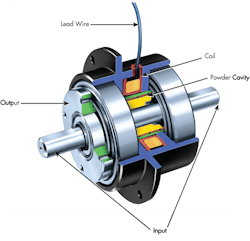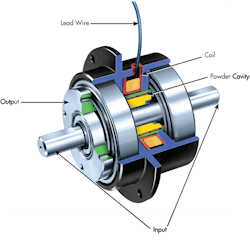What’s the Difference Between Torque-Control Solutions? (.PDF Download)
Electric clutches may not be always the engineer’s first choice when looking at torque-control solutions. Electric motor drive systems, pneumatic clutches, or even friction spring types are thought of first, but certain unique styles of electromagnetic clutches lend themselves very well to tension and torque control. They basically fall into two categories: powered and non-powered.
Powered Units
Magnetic particle clutches
These clutches are typically found in applications that prefer controlled slip or controlled slip speeds. Often used for tensioning in winding applications, these clutches have very precise, electrically controlled variable torque. Since torque is controlled by varying current, torque will not vary across changing slip speeds. When used per design recommendations, they feature smooth, repeatable torque.
To engage the clutch, current is applied to the field coil, creating an electromagnet that results in magnetic flux. Small magnetic particles (ceramic-coated pieces of steel) in the open clutch cavity attract to each other along the lines of flux. Normally, the input and output parts of the clutch are separate, but when the particles bind together, they start to attract to each other and rotation is transferred from the input to the output.
Magnetic particle clutch

